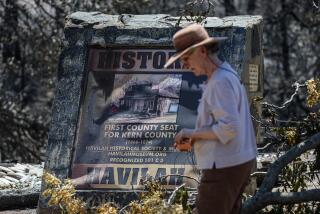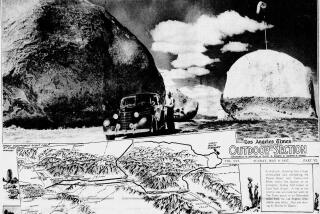In California’s Placerville, nuggets of history
Placerville, Calif.
In the foothills of the Sierra, in a small city once known as Hangtown, I sit quietly in the corner of an abandoned mine tunnel sipping a cappuccino. It is just after 9 on a Saturday morning and the Cozmic Café has been open more than an hour. The Cozmic is the latest business to inhabit this building, constructed around an idle mine shaft in 1859. Through the steam rising from my mug, I study walls of brown and green rock bearing the chisel marks of picks and axes.
Floodlights illuminate the splintering gray beams bracing the 5-foot ceiling. I try to imagine the Cozmic 140 years ago when it wasn’t the Cozmic but the Pearson Soda Works and the surrounding creeks and ravines were littered with gold.
In 10 steps, I pass through the tunnel’s entrance and into the front room of the cafe, abandoning 19th century twilight for 21st century sunlight. On the Cozmic’s massive wooden beams -- painted purple with gold stars -- posters advertise yoga classes, upcoming events at nearby Lake Tahoe and a concert later in the evening. I ask the tie-dye-clad, twentysomething cook about the origins of Placerville’s noose-related nickname.
“They used to hang people here, that’s all,” he says softly. “They don’t do it anymore.”
Placerville sprang into existence in 1848 when James Marshall discovered gold in nearby Coloma. In the next couple of years, thousands passed through, purchasing picks and wheelbarrows, coffee and sugar. They lifted, dug, panned, scooped and otherwise extracted millions in gold from the surrounding creek beds and ravines.
Today, day-trippers stop in Placerville (population 9,400) on the way to Tahoe, 57 miles to the east, or Sacramento, 45 miles to the west. The orchards on Apple Hill draw thousands every fall, and the diverse collection of pine trees in Eddy Arboretum attracts botanists from around the world. Anyone interested in Gold Rush history would be hard-pressed to find a more intriguing weekend destination. (Placerville is reportedly the only city municipality in the U.S. with its own gold mine.)
I spend the next few hours stepping between centuries. One minute, I see a baker peddling free slices of cake from shop to shop and the next I imagine 1856 and a fire raging across town, or 1860 and a Pony Express rider galloping through. Bakeries and cafes, lodged in buildings dating to the 1800s, project Placerville’s densely layered history into the present.
Many structures bear the dates of their construction on their stone and brick facades. The Masonic temple was erected in 1893, and the Cary House Hotel -- the former home of Wells Fargo Bank and a stagecoach stop -- opened in 1857. Today, coffeepots and brooms, miniature stagecoaches and sluicing pans fill the front windows of Placerville Hardware, reportedly the oldest continuously operating hardware shop west of the Mississippi.
Around the corner, a mural honors John “Snowshoe” Thompson, who twice a month carried mail and supplies 90 miles over the Sierra in winter. As I study the hills above town, pine trees dense as porcupine quills, I try to imagine strapping on a 70-pound pack and heading east without so much as a compass.
Across from the Cary House, a dummy dressed in a white shirt and black boots dangles from a noose at the Hangman’s Tree saloon. I’m not clear about the incident that turned the town originally known as Dry Diggins into Hangtown, so I walk a block east to the oldest building on Main Street, a former soda water factory that now houses the El Dorado County Historical Society.
“They only hung three,” says Bob Gatlin, one of the volunteers who staff the shop. “More publicity than hanging.” From what I can tell, the hangings occurred when someone jumped someone else’s claim or purse or poker winnings and -- there being a pronounced lack of prescribed legal process in post-Mexican, pre-statehood California -- the locals settled the matter as they saw fit.
Things have changed a bit since then. In the next two blocks I count 11 law offices. One is lodged between an insurance company and Hangtown Tattoo & Piercing (“You think it, we ink it”). Another, a criminal law practice above Olde Tyme Candy & More, offers “free consultation.” It took a few such lawyers, one incorporation (1854), one disbanding (1870), and another incorporation (1900) before Hangtown transformed itself into the modern city of Placerville and the El Dorado County seat.
Gatlin shows me a photo of John Studebaker, who spent a few years in Hangtown building wheelbarrows before he headed back east to found his wagon and auto empires. Studebaker was in town when fire broke out in 1856.
“I was one of the fire laddies who tried to put it out with our hand engine,” he wrote later in a letter, “but we had to abandon it as the fire was too swift. . . . “ When it was over, little was left standing in Hangtown. “I gathered up my gold nuggets as the fire was not hot enough to melt them,” Studebaker wrote, “and that was all I had left.”
I head across town to the local museum for a quick look at its collection of Studebaker wagons. The El Dorado County Historical Museum is the antidote to blockbuster exhibitions with masses of headphone-clad art lovers crammed 10 deep and 10 wide before an oil painting the size of a notebook.
I have the place to myself. I pore over a 1902 ledger from the Cary House, where I am spending the night.
Around the corner, a Pony Express poster advertises job openings: “Riders Wanted. Young, skinny, wiry fellows. Anxious for adventure and chance to see our great WEST. Must be expert riders, willing to risk death daily. Orphans preferred.”
Mounted on the wall -- beside a stagecoach, a surrey and a sheepherder’s covered wagon -- hang Snowshoe Thompson’s skis. Carved from an oak tree on his ranch, they measure more than 9 feet long, weigh 25 pounds and attach to the foot with a single toe strap.
In the next room, the museum has re-created a turn-of-the-19th century general store. Its shelves are lined with things I store in my kitchen -- vanilla extract, salted almonds, mustard and cloves -- and brands I’d never heard of -- Bale’s Smoked Lunch Herring, Meysee’s Oysters and Crystallized Canton Ginger. Tins of marshmallows separate canned pears from Hercules Powder and Allspice. Next door, the apothecary stocks less-appetizing essentials -- hog cholera cure, peerless hoof ointment, lice killer (liquid or powder), bloat cure and animal dip.
The exhibitions allow me to envision the buildings I saw earlier on Main Street, emptied of their contemporary trappings and arranged as they might have looked 150 years earlier, when would-be millionaires were overwhelming California. With that in mind, I take a reprint of the 1877 Omaha Herald’s “Tips for Stagecoach Travelers” and head northwest to the Coloma Valley and Sutter’s Mill.
In January 1848, while trying to free the waterwheel powering John Sutter’s sawmill, James Marshall shoveled aside a pile of gravel, picked up four or five gold nuggets and set off one of the largest mass migrations in American history. Within six months, 5,000 people had arrived in California and, within a year, 50,000 from Mexico, Hawaii, Germany, France, England, Peru, Chile, Australia, China and Africa.
Miners in Coloma found placer gold -- gold particles that had been freed from decomposing quartz over thousands of years and washed downstream. Many of the first prospectors simply bent over the banks of the river and picked them up.
Much of the Sutter’s Mill area -- James Marshall’s cabin, the Wah Hop store and the Olde Coloma Theatre -- is now preserved as the Marshall Gold Discovery State Historic Park. In the distance, white gold hills roll down to the American River, which curls through groves of yellow aspen in the former home of the Nisenan and foothill Miwok Indians. After a quick tour of the park, I wander down to the river, thinking about how Marshall’s discovery had changed California.
It strikes me that Sutter’s Mill is California’s true epicenter -- its effects rippling not only through the state but through much of the world. Staring at the river sparkling in the sun, I think about the value of gold in the 19th century and the value of water in the 21st. The relative value of resources is shifting in ways not even the most prescient miner might have imagined.
I pull out the “Tips for Stagecoach Travelers” and compare the guidelines for travelers journeying to Coloma in 1877 with those making the trip today. “Don’t keep the stage waiting. Don’t a smoke [sic] strong pipe inside the coach. Spit on the leeward side. If you have anything to drink in a bottle pass it around. . . . Don’t lag at the wash basin. Don’t grease your hair, because travel is dusty. Don’t imagine for a moment that you are going on a picnic. Expect annoyances, discomfort and perhaps some hardships.”
I open a bottle of water, take a sip and wish I could pass it to Snowshoe Thompson. In an era when tens of thousands were traveling thousands of miles in hopes of striking it rich, Thompson spent 12 years traversing the snowy Sierra, delivering mail, medicine and news to the remotest of areas, even though the Placerville postmaster couldn’t pay him a dime.
Comments? Email travel-feedback@latimes.com
More to Read
Sign up for The Wild
We’ll help you find the best places to hike, bike and run, as well as the perfect silent spots for meditation and yoga.
You may occasionally receive promotional content from the Los Angeles Times.






